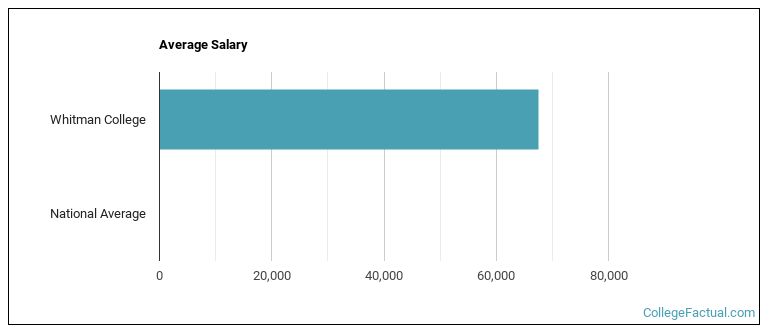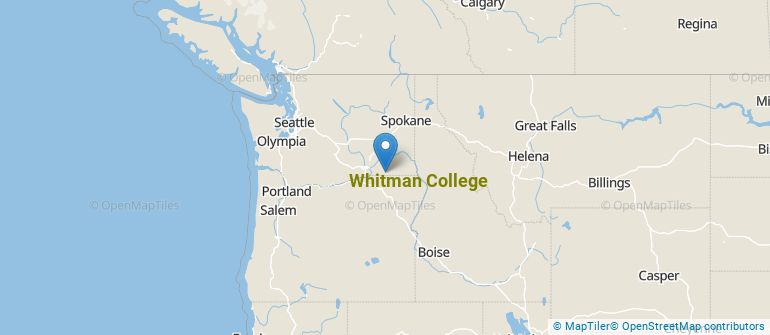 by our College Data Analytics Team
by our College Data Analytics TeamExplore the best ranked schools for the programs you are most interested in.
Whitman is ranked #791 out of 2,152 schools in the nation for overall quality on College Factual's 2025 Best Colleges list.
The acceptance rate at Whitman College is a competitive 48%, so make sure you take your application seriously when putting it together. Even leaving out a minor detail could be a reason to move you to the rejection pile.
About 14% of students accepted to Whitman submitted their SAT scores. When looking at the 25th through the 75th percentile, SAT Evidence-Based Reading and Writing scores ranged between 645 and 740. Math scores were between 648 and 733.
At Whitman, the student to faculty ratio is an excellent 9 to 1. That's much better than the national average of 15 to 1. This indicates that many classes will probably be small, and students will have ample opportunites to work closely with their professors and classmates.
When estimating how much access students will have to their teachers, some people like to look at what percentage of faculty members are full time. This is because part-time teachers may not have as much time to spend on campus as their full-time counterparts.
The full-time faculty percentage at Whitman College is 89%. This is higher than the national average of 47%.
Whitman College has a freshmen retention rate of 88%. That's a good sign that full-time students like the school and their professors enough to want to stick around for another year. It's also a sign that the admissions team did a good job in choosing applicants who were a good fit for the school.
The on-time graduation rate for someone pursuing a bachelor's degree is typically four years. This rate at Whitman for first-time, full-time students is 79%, which is better than the national average of 33.3%.
Find out more about the retention and graduation rates at Whitman College.
During the 2017-2018 academic year, there were 1,360 undergraduates at Whitman with 1,288 being full-time and 72 being part-time.
| $0-30 K | $30K-48K | $48-75 | $75-110K | $110K + |
|---|---|---|---|---|
| $20,462 | $26,059 | $29,749 | $28,359 | $43,855 |
The net price is calculated by adding tuition, room, board and other costs and subtracting financial aid.Note that the net price is typically less than the published for a school. For more information on the sticker price of Whitman, see our tuition and fees and room and board pages.
While almost two-thirds of students nationwide take out loans to pay for college, the percentage may be quite different for the school you plan on attending. At Whitman, approximately 41% of students took out student loans averaging $6,438 a year. That adds up to $25,752 over four years for those students.

Get more details about the location of Whitman College.

Contact details for Whitman are given below.
| Contact Details | |
|---|---|
| Address: | 345 Boyer Ave, Walla Walla, WA 99362 |
| Phone: | 509-527-5111 |
| Website: | www.whitman.edu/ |
| Most Popular Majors | Bachelor’s Degrees | Average Salary of Graduates |
|---|---|---|
| Child Development & Psychology | 34 | NA |
| General Biology | 33 | $28,538 |
| Political Science & Government | 32 | $27,689 |
| Economics | 22 | $46,832 |
| General English Literature | 21 | $25,574 |
| History | 21 | NA |
| Sociology | 19 | NA |
| Biochemistry, Biophysics & Molecular Biology | 17 | NA |
| Computer Information Systems | 16 | NA |
| Philosophy | 15 | NA |
If you’re considering Whitman College, here are some more schools you may be interested in knowing more about.
Curious on how these schools stack up against Whitman? Pit them head to head with College Combat, our free interactive tool that lets you compare college on the features that matter most to you!
Footnotes
*The racial-ethnic minorities count is calculated by taking the total number of students and subtracting white students, international students, and students whose race/ethnicity was unknown. This number is then divided by the total number of students at the school to obtain the racial-ethnic minorities percentage.
References
More about our data sources and methodologies.